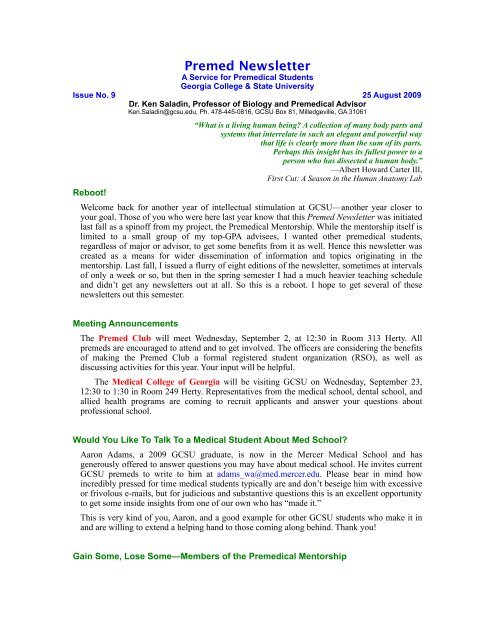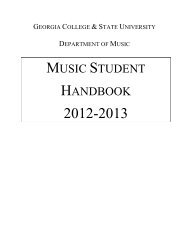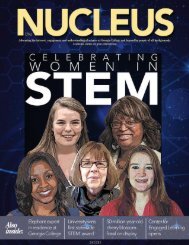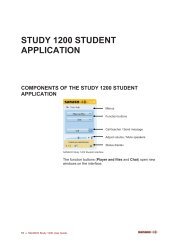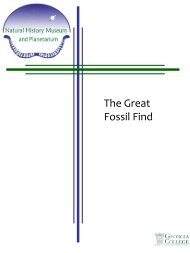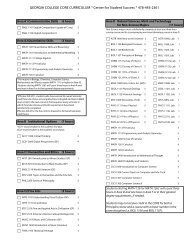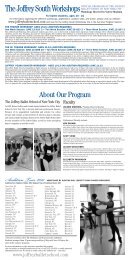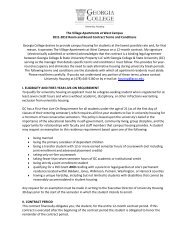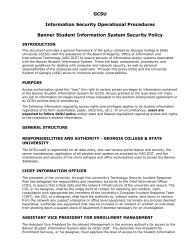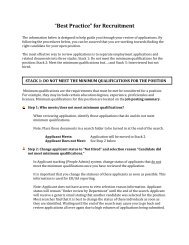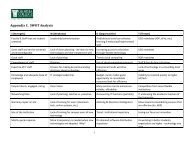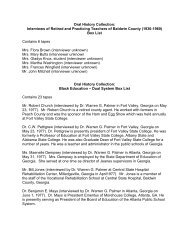Pre-Med Newsletter Issue 9 - Georgia College & State University
Pre-Med Newsletter Issue 9 - Georgia College & State University
Pre-Med Newsletter Issue 9 - Georgia College & State University
You also want an ePaper? Increase the reach of your titles
YUMPU automatically turns print PDFs into web optimized ePapers that Google loves.
<strong>Pre</strong>med <strong>Newsletter</strong><br />
A Service for <strong>Pre</strong>medical Students<br />
<strong>Georgia</strong> <strong>College</strong> & <strong>State</strong> <strong>University</strong><br />
<strong>Issue</strong> No. 9 25 August 2009<br />
Dr. Ken Saladin, Professor of Biology and <strong>Pre</strong>medical Advisor<br />
Ken.Saladin@gcsu.edu, Ph. 478-445-0816, GCSU Box 81, Milledgeville, GA 31061<br />
Reboot!<br />
“What is a living human being? A collection of many body parts and<br />
systems that interrelate in such an elegant and powerful way<br />
that life is clearly more than the sum of its parts.<br />
Perhaps this insight has its fullest power to a<br />
person who has dissected a human body.”<br />
—Albert Howard Carter III,<br />
First Cut: A Season in the Human Anatomy Lab<br />
Welcome back for another year of intellectual stimulation at GCSU—another year closer to<br />
your goal. Those of you who were here last year know that this <strong>Pre</strong>med <strong>Newsletter</strong> was initiated<br />
last fall as a spinoff from my project, the <strong>Pre</strong>medical Mentorship. While the mentorship itself is<br />
limited to a small group of my top-GPA advisees, I wanted other premedical students,<br />
regardless of major or advisor, to get some benefits from it as well. Hence this newsletter was<br />
created as a means for wider dissemination of information and topics originating in the<br />
mentorship. Last fall, I issued a flurry of eight editions of the newsletter, sometimes at intervals<br />
of only a week or so, but then in the spring semester I had a much heavier teaching schedule<br />
and didn’t get any newsletters out at all. So this is a reboot. I hope to get several of these<br />
newsletters out this semester.<br />
Meeting Announcements<br />
The <strong>Pre</strong>med Club will meet Wednesday, September 2, at 12:30 in Room 313 Herty. All<br />
premeds are encouraged to attend and to get involved. The officers are considering the benefits<br />
of making the <strong>Pre</strong>med Club a formal registered student organization (RSO), as well as<br />
discussing activities for this year. Your input will be helpful.<br />
The <strong>Med</strong>ical <strong>College</strong> of <strong>Georgia</strong> will be visiting GCSU on Wednesday, September 23,<br />
12:30 to 1:30 in Room 249 Herty. Representatives from the medical school, dental school, and<br />
allied health programs are coming to recruit applicants and answer your questions about<br />
professional school.<br />
Would You Like To Talk To a <strong>Med</strong>ical Student About <strong>Med</strong> School?<br />
Aaron Adams, a 2009 GCSU graduate, is now in the Mercer <strong>Med</strong>ical School and has<br />
generously offered to answer questions you may have about medical school. He invites current<br />
GCSU premeds to write to him at adams_wa@med.mercer.edu. Please bear in mind how<br />
incredibly pressed for time medical students typically are and don’t beseige him with excessive<br />
or frivolous e-mails, but for judicious and substantive questions this is an excellent opportunity<br />
to get some inside insights from one of our own who has “made it.”<br />
This is very kind of you, Aaron, and a good example for other GCSU students who make it in<br />
and are willing to extend a helping hand to those coming along behind. Thank you!<br />
Gain Some, Lose Some—Members of the <strong>Pre</strong>medical Mentorship
2<br />
We’ve lost one mentorship member this year, as Megan Culligan has transferred to Valdosta<br />
<strong>State</strong> <strong>University</strong> in order to spend the year with her family before their planned move to<br />
Chicago next year. We’ll miss Megan. Invitations were extended to, and accepted by, two new<br />
members at the start of spring semester and one new member this semester—Dupe Babalola,<br />
Christin Sams, and Jared White. Current members are therefore:<br />
Dupe Babalola<br />
Christie Hall<br />
Krystal Meadows<br />
Christin Sams<br />
Catlyn Thigpen<br />
Jared White<br />
Jenny White<br />
Melanie Wooten<br />
<strong>Pre</strong>med Club Tours “Bodies—The Exhibition”<br />
Just to catch up with a little old news since I didn’t issue any newsletters spring semester:<br />
Twenty-six <strong>Pre</strong>med Club members and others traveled on February 28 to the <strong>Pre</strong>mier<br />
Exhibition Center at Atlantic Station, Atlanta to see “Bodies—The Exhibition.” This is a<br />
display of dissected human bodies preserved by the process of plastination. By freeze-drying an<br />
organ or an entire body and replacing all the water with plastic resin (silicone, polyester, or<br />
epoxy), this technique remarkably preserves the size, shape, color, and even microscopic<br />
structure of the original tissues almost indefinitely. The results are dry, lightweight, lifelike<br />
specimens that can be easily handled. Plastination is now used on a wide variety of biological<br />
specimens, but none so dramatic or fascinating to the public as the human body.<br />
[photo deleted because it made document too big to be e-mailable]<br />
Plastinated arteries of the head, from Gunther von<br />
Hagens, “Body Worlds”.<br />
Gunther von Hagens, the inventor of plastination, creates a similar show, “Body Worlds,”<br />
that tours major cities of the world. It is currently showing in San Diego, Buffalo, London,<br />
Berlin, Augsburg, and Haifa. “Bodies—The Exhibition” originates from China and is still<br />
showing in Atlanta, as well as Bloomington MN; Ledyard CT; Las Vegas; New York; and<br />
beyond our borders in Quebec City, Cologne, and Brno.<br />
The specimens I found most striking and memorable were a uterus with the largest fibroids<br />
I’ve ever seen, and various specimens that reveal the tremendous density of blood vessels in the<br />
tissues, far beyond, of course, the named vessels we teach in anatomy. The image above, a good<br />
example of this, is from the catalog of the von Hagens exhibition.<br />
What struck me less favorably about “Bodies—The Exhibition,” however, is that it seemed<br />
to be put together somewhat carelessly. The dissections weren’t as clean (they were a bit more<br />
ragged in several places) than I’ve seen elsewhere. Half of one exhibit room, and isolated<br />
display cases in some of the other rooms, were without electrical power, leaving specimens in<br />
the dark and barely visible; I was tempted to ask for a refund of a commensurate percentage of<br />
my admission price. I also found about a dozen anatomical features misidentified—misnamed<br />
muscles, labels in the wrong place, and so forth. In short, I was not entirely impressed with the<br />
professionalism of the exhibition. It looked like a cheaper, more hastily created imitation of the<br />
von Hagens exhibit, slapped together to capitalize on the craze. The long lines of people<br />
waiting to get in at $26 a pop, day after day, month after month, certainly attests to the money<br />
to be made from the exhibition of human bodies.<br />
But despite its flaws, “Bodies—The Exhibition” is fascinating nonetheless, and for those<br />
who have never seen cadaver dissections or plastinated specimens, I recommend a visit while<br />
it’s still in Atlanta. It will deepen your sense of awe toward the human body. It is scheduled to<br />
run through January 3. Adult tickets are $25.92. For further information, go here:
3<br />
http://www.atlanticstation.com/bodies-the-exhibition.php<br />
For interesting information about these exhibits, including controversy and ethical<br />
questions over how the Chinese bodies were obtained, see also the Wikipedia articles: “Bodies<br />
the Exhibition” and “Body Worlds”.<br />
Thanks especially to Krystal Meadows for coordinating the <strong>Pre</strong>med Club trip.<br />
In the Mentorship—Spring 2009<br />
Since I didn’t issue any newsletters last spring, let me tell you some of the highlights of that<br />
semester’s <strong>Pre</strong>med Mentorship.<br />
The mentorship always involves the reading and discussion of one book each semester. Fall<br />
semester we read Albert Carter’s First Cut, about the lives of first-year medical students at<br />
Emory <strong>University</strong>, especially their experience and evolving attitudes toward the human<br />
cadavers in gross anatomy. Spring semester we read Jerome Groopman’s How Doctors Think,<br />
about doctor-patient relationships and communication, and on the cognitive processes (and<br />
errors) of diagnostic medicine. (See the next article regarding this semester’s reading.) We also<br />
had a pizza and movie party at my home to watch Michael Moore’s film, “Sicko,” setting a<br />
stage for this year’s discussion of health-care policy and reform.<br />
The Groopman book, among other sources, often led us to tangential but fruitful<br />
discussions of many topics. Among other things spring semester, we looked at (sometimes with<br />
PowerPoint slideshows) the history of surgical anesthesia, the medical art of Rembrandt,<br />
arthroscopic knee surgery, Stryker saws, trepanation, cremation, ectopic (tubal and abdominal)<br />
pregnancy, and communicating more professionally even in casual conversation and e-mails.<br />
In looking at the American health-care system, its advantages, and its problems, we are also<br />
comparing health care in other countries. Dr. Kwan Christenson gave a slide presentation on<br />
health care in Thailand, where she earned her M.D. and practiced medicine before moving to<br />
the United <strong>State</strong>s. Dupe Babalola gave a fascinating presentation on the terrible violence<br />
against suspected “witch children” in her country, Nigeria (for films on this, direct the Google<br />
Videos search engine to “Witch Children Nigeria”). I showed slides from my observations of<br />
public health in the Dominican Republic in the late 1970s. In Maymester, Megan Culligan<br />
and Melanie Wooten went with me to Ecuador, where we visited a hospital in the town of<br />
Puerto Ayora in the Galápagos Islands. We were very fortunate to get a good interview with the<br />
hospital director (with Megan serving as our translator) and a tour of the hospital.<br />
As always, the mentorship places an emphasis on peer-evaluation and MCAT preparation,<br />
and we had several spring semester writing exercises—practice AMCAS admission essays and<br />
impromptu MCAT-style essays. Anonymous copies of the essays are distributed to everyone in<br />
the group, with everyone providing anonymous, candid critiques of each the other members’<br />
writing. Mentees have said they find this very helpful, not only for the constructive criticism<br />
received from their peers, but also because in evaluating someone else’s writing, they become<br />
more aware of ways in which their own writing could have been better. As I read their latest<br />
essays, I felt there had been a lot of improvement since our first efforts fall semester. These<br />
students are writing much more sharply focused, tightly organized, effective MCAT essays than<br />
they did at first, and they are drawing ever closer to having an excellent admission essay ready<br />
by the time they file their AMCAS applications—which, for most, comes at the end of this year<br />
of mentoring. Dr. Rosalie Richards says she hopes to extend MCAT essay practice to other<br />
premedical students, and we expect to meet soon to exchange some essay topics for that<br />
purpose. This might be a very beneficial activity for the <strong>Pre</strong>med Club this year.<br />
We’ve also had practice Verbal Reasoning and Life Science MCAT exams. Students have<br />
found these to be sobering experiences—showing just how unready we are for the real MCAT
4<br />
as yet, and giving mentees some feeling for the nature of the MCATs. This year, as more<br />
students in the group take organic chemistry and physics, we expect to have more complete<br />
practice MCATs including at least one full-length practice exam.<br />
In the Mentorship—Fall 2009<br />
We’ve had just one meeting so far this semester (August 20), so there’s relatively little to report<br />
as yet. Each member described the clinical experiences she or he had over the summer. I was<br />
very impressed! These were very enriching experiences, not only in patient contact in clinical<br />
settings but also in networking—building relationships with medical professionals who may be<br />
good sources of recommendation letters to medical school later. These students are doing<br />
exactly what is needed to strengthen their likelihood of medical school admission, and to<br />
explore and reaffirm the sincerity of their interest in the medical profession. I found it<br />
particularly impressive that several or most of the mentees earned such a level of trust by their<br />
physician-mentors that they were allowed to perform some hands-on clinical procedures with<br />
patients and not merely stand around watching other people do things.<br />
We’ll place increasing emphasis on MCAT preparation this year, since seven of the eight<br />
members are now juniors and will be taking the MCAT sometime in 2010. We discussed MCAT<br />
preparation strategies including the pros and cons of the Kaplan MCAT course. Krystal<br />
obtained some information on the Kaplan course that I’m sure she will happily pass on to the<br />
<strong>Pre</strong>med Club.<br />
Our reading this semester is Understanding Health Policy by Thomas Bodenheimer and<br />
Kevin Grumbach. This is a slim textbook for medical, nursing, P.A., and other health-science<br />
students that covers issues of accessibility, affordability, and administration of U.S. health care,<br />
health insurance, <strong>Med</strong>icare/<strong>Med</strong>icaid, and related matters. Thus, our reading over the first three<br />
semesters of mentorship is progressing from the medical student to the individual physician and<br />
now to the broader issues of the whole U.S. health-care system. <strong>Pre</strong>vious recruiters from<br />
Mercer and MCG have said that they like to see applicants show some familiarity with the<br />
national health-care system. This reading, a study of the Obama Administration’s health-care<br />
reform plan, and attention to the news revolving around the Obama plan should give these<br />
students a pretty good insight to take with them into their admission interviews, in case the<br />
subject comes up there.<br />
Our study of health care in other countries is soon to be further widened by a presentation<br />
from my new premedical advisee, Ahmed al-Bayati, who comes to GCSU from Iraq and<br />
whose parents both practice medicine in Baghdad. In my first meeting with Ahmed, I was<br />
particularly impressed with his account of the extreme difficulty and danger facing physicians<br />
in Iraq at this time. I’m pleased that he has accepted my invitation to tell his story to the<br />
mentorship.<br />
What Would Osler Do?—Recommended Reading<br />
Probably anyone with Emergency Room experience has encountered “frequent fliers,” patients<br />
who may or may not have personal physicians or health insurance, and who come in time after<br />
time for various complaints. Some are homeless, mentally ill, have substance abuse problems,<br />
and may be combative or abusive toward E.R. staff. Dealing effectively and compassionately<br />
with such patients may be among a health-care worker’s greatest communication challenges. In<br />
the mentorship, we’re reading an article about this from one of this summer’s issues of the New<br />
England Journal of <strong>Med</strong>icine—Michael Kahn, “What would Osler do?” NEJM 361:442–443<br />
(30 July 2009). Kahn describes an exercise that he calls “Difficult Patient Rounds” for thirdyear<br />
medical students on their clerkship rotations. He shows that compassionate<br />
communication even with the most difficult and least likeable patients can open the door to a
5<br />
more effective physician–patient therapeutic relationship. Interested premeds may get a copy of<br />
this article from my office (236 Herty).<br />
So Who Was Osler?<br />
Perhaps Kahn’s title has led you to wonder who Osler was and why Kahn invoked Osler’s<br />
name. Osler is a name that any literate medical student should know, and any premed would be<br />
at some advantage to know—perhaps on a level with a history student knowing well the names<br />
of Jefferson and Madison.<br />
[Osler portrait deleted]<br />
Sir William Osler (1849–1919) was in many respects a key founder of modern American medical<br />
education. Born in Ontario, Osler first aspired to enter the Anglican ministry, but in college he<br />
found medicine more interesting. Trained in Toronto and Europe, he returned to a professorship at<br />
McGill <strong>University</strong> in Montreal; then became Chair of Clinical <strong>Med</strong>icine at the <strong>University</strong> of<br />
Pennsylvania; and finally held appointments both at Oxford <strong>University</strong> in England and as the first<br />
chief of staff at Johns Hopkins Hospital in Baltimore and one of the first professors of medicine<br />
at Johns Hopkins <strong>University</strong>.<br />
Osler invented the concept of medical residency, which then meant that young M.D.s lived in<br />
the hospital, leading an almost monastic life isolated from the outside world, for as long as seven<br />
or eight years. He also was the founder of clinical clerkships—training advanced medical students<br />
through rounds in the patient wards. Osler insisted that medical students and residents learn not<br />
merely from books, but from hands-on compassionate care of and communication with patients.<br />
He insisted that medical students get bedside experience early in their training, and placed greater<br />
emphasis on this than on didactic sessions in the lecture hall. By their third year, Osler had<br />
medical students taking patient histories and performing physical examinations and lab tests.<br />
Osler had a well-known sense of humor and prankster spirit that sometimes led to his being<br />
taken the wrong way. Arguing that the most important, vitalizing work in the world is done by<br />
people from 25 to 40 years old, he quipped “It’s all downhill from there” and satirically<br />
envisioned a college in which professors retired at the age of 67 and were “peacefully<br />
extinguished” with chloroform a year later. The popular press took him a little too seriously and<br />
with undue alarm at his whimsical suggestion of euthanizing elderly medical professors. Osler<br />
died at 70 in the Spanish influenza epidemic of 1919.<br />
Students hoping for a medical school admissions interview could do worse than having a<br />
little awareness of medical history, especially such luminaries as Sir William Osler. One can do<br />
no better in capturing Osler’s spirit and teaching philosophy than to offer a few aphoristic quotes<br />
from him:
6<br />
I desire no other epitaph…than the statement that I taught<br />
medical students in the wards, as I regard this as by far the<br />
most useful and important work I have been called upon to<br />
do.<br />
He who studies medicine without books sails an uncharted<br />
sea, but he who studies medicine without patients does not<br />
go to sea at all.<br />
If you listen carefully to the patient they will tell you the<br />
diagnosis.<br />
Source: Wikipedia, “William Osler”<br />
The Hippocratic Oath<br />
Graduating medical students traditionally swear an oath of professional ethics just before the<br />
M.D. degree is conferred upon them. One popular misconception is that they swear the<br />
Hippocratic Oath. Another is that the oath begins with or contains the maxim “First, do no<br />
harm” (primum non nocere, more literally translated “First, not to harm”). Neither is true.<br />
Primum non nocere has been authoritatively traced only as far back as the 1600s, and is<br />
primarily a maxim for emergency medical care—apprising the physician that it is sometimes<br />
better to do nothing than to undertake a procedure that could do more harm than good.<br />
The Hippocratic Oath is commonly thought to have been written or spoken by Hippocrates<br />
(ca. 460–370 BCE), the father of western medicine, or by one of his students expressing his<br />
teacher’s ideals. Although of historic interest, it would seem rather archaic, irrelevant, even<br />
bizarre, for medical students today to recite the classic oath. Many Christian, Muslim, and<br />
Jewish physicians today even regard it as blasphemous in its invocation of the pagan deities. In<br />
one of several English translations from the Greek, 1 the classic oath reads:<br />
I swear by Apollo the Physician and Asclepius and Hygieia and<br />
Panaceia and all the gods and goddesses, making them my witnesses,<br />
that I will fulfill according to my ability and judgment this oath and this<br />
covenant:<br />
To hold him who has taught me this art as equal to my parents and to<br />
live my life in partnership with him, and if he is in need of money to<br />
give him a share of mine, and to regard his offspring as equal to my<br />
brothers in male lineage and to teach them this art - if they desire to<br />
learn it - without fee and covenant; to give a share of precepts and<br />
oral instruction and all the other learning to my sons and to the sons<br />
of him who has instructed me and to pupils who have signed the<br />
covenant and have taken an oath according to the medical law, but no<br />
one else.<br />
I will apply dietetic measures for the benefit of the sick according to<br />
my ability and judgment; I will keep them from harm and injustice.<br />
I will neither give a deadly drug to anybody who asks for it, nor will I<br />
make a suggestion to this effect. Similarly I will not give to a woman<br />
an abortive remedy. In purity and holiness I will guard my life and my<br />
art.<br />
I will not use the knife, not even on sufferers from stone, but will<br />
withdraw in favor of such men as are engaged in this work.
7<br />
Whatever houses I may visit, I will come for the benefit of the sick,<br />
remaining free of all intentional injustice, of all mischief and in<br />
particular of sexual relations with both female and male persons, be<br />
they free or slaves.<br />
What I may see or hear in the course of the treatment or even outside<br />
of the treatment in regard to the life of men, which on no account one<br />
must spread abroad, I will keep to myself, holding such things<br />
shameful to be spoken about.<br />
If I fulfil this oath and do not violate it, may it be granted to me to<br />
enjoy life and art, being honored with fame among all men for all time<br />
to come; if I transgress it and swear falsely, may the opposite of all<br />
this be my lot.<br />
Among other outmoded provisions in the classic oath, paragraph 2 is a reference to the ancient<br />
method of medical education, through mentoring. Paragraph 5 (“I will not use the knife…”)<br />
alludes to the fact that ancient physicians considered surgery beneath their dignity, properly left<br />
to lower-ranking “barber-surgeons.” “Stone” refers to kidney stones and their surgical removal<br />
from the bladder.<br />
However outmoded the exact words and provisions of the Hippocratic Oath may be today,<br />
some of its precepts are not without merit. Moreover, it remains an admirable practice for all<br />
time for soon-to-be-physicians to swear by a code of ethics and to regularly think about it in<br />
relation to their professional practices. So most medical students in the U.S. do take an oath<br />
before receiving the degree, but the oath varies from school to school. One of the most widely<br />
used today is this one, now 45 years old, written by Dr. Louis Lasagna, Academic Dean of the<br />
Tufts <strong>University</strong> School of <strong>Med</strong>icine. 2<br />
I swear to fulfill, to the best of my ability and judgment, this covenant:<br />
I will respect the hard-won scientific gains of those physicians in<br />
whose steps I walk, and gladly share such knowledge as is mine with<br />
those who are to follow.<br />
I will apply, for the benefit of the sick, all measures [that] are<br />
required, avoiding those twin traps of overtreatment and therapeutic<br />
nihilism.<br />
I will remember that there is art to medicine as well as science, and<br />
that warmth, sympathy, and understanding may outweigh the<br />
surgeon's knife or the chemist's drug.<br />
I will not be ashamed to say "I know not," nor will I fail to call in my<br />
colleagues when the skills of another are needed for a patient's<br />
recovery.<br />
I will respect the privacy of my patients, for their problems are not<br />
disclosed to me that the world may know. Most especially must I tread<br />
with care in matters of life and death. If it is given me to save a life,<br />
all thanks. But it may also be within my power to take a life; this<br />
awesome responsibility must be faced with great humbleness and<br />
awareness of my own frailty. Above all, I must not play at God.
8<br />
I will remember that I do not treat a fever chart, a cancerous growth,<br />
but a sick human being, whose illness may affect the person's family<br />
and economic stability. My responsibility includes these related<br />
problems, if I am to care adequately for the sick.<br />
I will prevent disease whenever I can, for prevention is preferable to<br />
cure.<br />
I will remember that I remain a member of society, with special<br />
obligations to all my fellow human beings, those sound of mind and<br />
body as well as the infirm.<br />
If I do not violate this oath, may I enjoy life and art, respected while I<br />
live and remembered with affection thereafter. May I always act so as<br />
to preserve the finest traditions of my calling and may I long<br />
experience the joy of healing those who seek my help.<br />
1<br />
Ludwig Edelstein, 1943. The Hippocratic Oath: Text, Translation, and Interpretation. Baltimore: Johns<br />
Hopkins <strong>Pre</strong>ss.<br />
2<br />
http://www.pbs.org/wgbh/nova/doctors/oath_modern.html<br />
I Want to Be a Doctor Because…<br />
Perhaps you plan to write on that point in your AMCAS essay. You might be asked to explain<br />
your motive in an admission interview. Have you been thinking about what to say?<br />
Next to “because I want to make buckets of money,” perhaps one of the most banal and<br />
counterproductive things you could say is “because I want to help people.” An admissions<br />
committee member reading your AMCAS essay might just roll her eyes and toss your paper<br />
aside into the “another one of those” pile. An interviewer might well respond, “If you want to<br />
help people, why not become a plumber?” In short, you need to have something more<br />
substantive, more original, and less trite to say for yourself. As you can well imagine,<br />
admissions committee members have read hundreds, if not thousands of essays and seen<br />
countless clichés. How do you avoid writing in tedious clichés when, in fact, your motivation<br />
probably is much the same as the motivation of thousands of applicants preceding you? Here’s<br />
a source of useful advice:<br />
http://www.bestpremed.com//essayedge/lesson2.htm#article<br />
Alternative Careers in <strong>Med</strong>icine—Anesthesiologist Assistant<br />
Interested in a health-care career? Hoping for a comfortable income? Apprehensive about the<br />
long years and steep debt entailed in going through medical school and residency, or the long<br />
hours a physician is away from his or her family and home? Here’s an option you might want to<br />
consider—two years of education beyond your bachelor’s degree and you could be an<br />
anesthesiologist assistant, where starting salaries as of 2006 ranged from $95,000 to $120,000,<br />
and high-end salaries for those with experience were $160,000 to $180,000. 1<br />
An anesthesiologist assistant (AA) is a physician assistant (PA) specializing in anesthesia.<br />
AAs work under the supervision of anesthesiologists, usually in medical centers and pain<br />
clinics. The duties of an AA are identical to those of a nurse–anesthetist. Prior to surgery, the<br />
AA obtains the patient’s medical history and other relevant information, and performs such
9<br />
preparations as insertion of arterial and venous catheters. During surgery, the AA monitors and<br />
adjusts the anesthetic, I.V. fluids, and cardiac and other drugs; monitors peripheral nerve<br />
blockades; manages the patient’s airway; and performs cardiopulmonary resuscitation if<br />
needed. After surgery, the AA provides recovery room care. An AA is not to be confused with<br />
an anesthesia technician, who assists anesthesiologists, nurse–anesthetists, and AAs with the<br />
equipment, supplies, and patient care.<br />
To become an AA, one must earn a bachelor’s degree that includes the same prerequisites<br />
as for medical school, then take a 24- to 28-month postgraduate AA course of study and pass a<br />
certification exam. Currently there are five AA programs in the United <strong>State</strong>s, two of which are<br />
in <strong>Georgia</strong>: Emory <strong>University</strong> (Atlanta), South <strong>University</strong> (Savannah), Nova Southeastern<br />
<strong>University</strong> (Davie, FL), Case Western Reserve <strong>University</strong> (Cleveland, OH), and the <strong>University</strong><br />
of Missouri (Kansas City). The American Academy of Anesthesiologist Assistants 2 lists the web<br />
sites for those five programs and provides further information on AA careers.<br />
1<br />
American <strong>Med</strong>ical Association Health Care Careers Directory, 2008–2009, www.ama-assn.org/<br />
amal/pub/upload/mm/40/aa0809.pdf<br />
2<br />
www.anesthetist.org (“Facts about AAs” and “Education” links)<br />
Back <strong>Issue</strong>s<br />
If you are new to the <strong>Pre</strong>med <strong>Newsletter</strong>, you might be interested in some topics covered in last<br />
year’s issues. Back issues are available upon request to me at ken.saladin@gcsu.edu.<br />
<strong>Issue</strong> 1 (8/22/08)—Introduction to <strong>Pre</strong>med Mentorship; introduction to the book First Cut–A Season in<br />
the Human Anatomy Lab; the dropoff in premed numbers from freshman to junior year; <strong>Georgia</strong>’s doctor<br />
shortage.<br />
<strong>Issue</strong> 2 (8/29/08)—The medical art of Frank Netter; the Doris Moody biology honors scholarship;<br />
admission statistics of <strong>Georgia</strong>’s medical schools; an online calculator for evaluating your own chances<br />
at any U.S. medical school based on GPA, MCATs, and place of residence; the U.S. <strong>Med</strong>ical Licensing<br />
Examination; advice on whether to consider attending a Caribbean or Mexican medical college.<br />
<strong>Issue</strong> 3 (9/5/08)—Report of activities in the mentorship; trends in female enrollment in medical school;<br />
the medical history behind barber pole stripes; electives for premed biology majors; the ridiculous life of<br />
a big-chain retail pharmacist; ratings of five offshore medical schools.<br />
<strong>Issue</strong> 4 (9/12/08)—Report from the mentorship; the nature of the MCAT essays; the path to a career in<br />
medicine—steps from high school to private practitioner.<br />
<strong>Issue</strong> 5 (9/25/08)—Financing medical school–the Army Reserve <strong>Med</strong>ical Corps; William Harvey,<br />
pioneer physician–physiologist; scholarships for biomedical graduate study; an online source of medical<br />
school advice and information.<br />
<strong>Issue</strong> 6 (10/3/08)—Senior capstone opportunities in biology; report from the mentorship; a very short<br />
(but funny) medical dictionary.<br />
<strong>Issue</strong> 7 (10/15/08)—Updated admission statistics for <strong>Georgia</strong>’s medical schools; medical school letters<br />
of recommendation; popular minors for premeds; alternative careers with a degree in biology; career<br />
information in radiologic technology; the cycle of 4000-level biology course offerings; an impractical<br />
guide to scientific units of measurement.<br />
<strong>Issue</strong> 8 (11/07/08)—Mercer <strong>University</strong> visit to GCSU–advice on admissions; report from the<br />
mentorship; links to autopsy videos; a certain cell phone myth; alternative spring break for premeds;<br />
MCG’s “Resurrection Man” and medical grave-robbing in <strong>Georgia</strong>; expressing oneself professionally;<br />
ethnic, gender, and other data on <strong>Georgia</strong>’s 2006–07 matriculating medical class; advice on medical<br />
school admission interviews; study tips in undergraduate biomedical classes.


